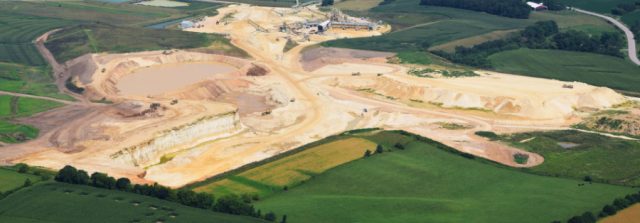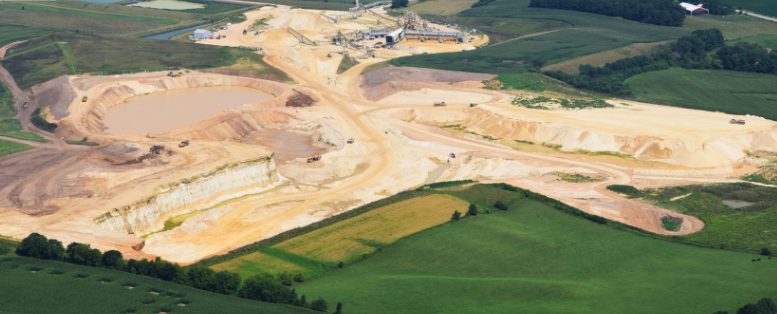
Frac Sand mine, Eau Claire County, Wisconsin.
By Christine Yellowthunder
Fractracker Alliance (10/29/18)
Most people living in Wisconsin, Minnesota and Iowa have increased their knowledge over the past six years regarding the fracking destruction occurring across the country. The horror of fracking damages to life and land remain in the minds of most people who live near the massive land destruction from silica sand mining for what the unconventional oil and gas industry lovingly calls “proppant”.
Very often, we in the Midwest wonder if the rest of the country knows that this specialized form of silica sand mining destroys our rolling hills, woodlands, and water sources in order for silica sand to feed the fracking industry’s insatiable proppant demand.
Those of us who live in the direct path of this unhealthy silica sand mining need to make our stories known.
Bridge Creek Town, Wisconsin
The quiet abundance of life on an 80-acre tree farm in Wisconsin, fed by natural springs and wetlands, has nurtured every dream this prairie-raised transplant could conceive in the last 30 years. Six years of vigilance and rational debate has led to loss on every front when addressing the local government’s permitting of silica sand mines and its health and safety impacts on the community.
The largest sand mine in Bridge Creek Town lies one mile north of our tree farm. Two years ago, 40 acres of trees were culled for the installation of high intensity power lines to feed anticipated silica sand mine expansion under the legal provision of “Right-of-Way.” That document was signed by a previous land owner in 1948. No specific amount of land was specified on the original right-of-way, thus allowing significant legal destruction and permanent loss against the farm.
However, from a tree farm owner’s perspective, we have seen the variety and number of wildlife species increase at our farm over the past six years – likely because these species view our farm as an oasis, or what ecologists call a refugium, in an otherwise altered mixed-use landscape. The maximum capacity of the tree farm as a wildlife sanctuary is unknown. The adjacent silica Hi-Crush sand mine depletes the hillsides and woodlots in its path.
Hi-Crush Partners LP’s frac sand mine
The weekly blasting away of the hillsides sends shock waves – shaking homes and outbuildings weekly, along with our nerves. Visible cracks appear in the walls of buildings, and private wells are monitored for collapse and contamination. The sand mine only guarantees repair to property lying within a half-mile of the mine. The mine blasts the land near Amish schools and has had a noticeable effect on the psyche of countless farm animals. The invisible silica is breathed by every living thing much to the mine’s denial, with deadly silicosis appearing up to 15 years after initial exposure. Our community is left to wonder who will manifest the health effects first. Blasting unearths arsenic, lead, and other contaminants into private wells and into the remaining soil.

Frac sand mine in Eau Claire County, Wisconsin.
There has been no successful reclamation of the land after it is mined, with most residents wondering what the actual point is of developing a reclamation plan is if timely implementation and stringent reclamation metrics are not enforced. All useful topsoil has been stripped away and is dead with the land only able to support sedge grasses and very few of them at best. No farming on this mined land can occur even though these mining companies promise farm owners that when they are done mining, soil productivity will meet or exceed pre-mining conditions and much milder slopes than the pre-mining bluffs that contained the silica sand. Needless to say, land values of homes, farms, and property decrease as the mines creeps closer.
The people of Bridge Creek
Bridge Creek, as well as many other towns, have been easy picking for the mines. Many towns are unzoned, having little industry, a meager tax base, and a huge land area for a very sparse population. The unemployment and underemployment rates are quite high. Many residents in Bridge Creek farm, including a very large population of Amish who own a checkerboard of land used for farming and saw mills. Most of these Amish families arrived here from Canada and bought farms when the mid 80’s drought put small farms up for sale. The Amish community seldom votes, and their strong religious beliefs prevent them from taking a stand on any political issues.
The original residents of this land, the Ho-Chunk people, are few in number and wish to protect their home lands that they had purchased back from the government.
Furthermore, a significant number of artists live in this community and have chosen to keep their homes and studios in anonymity. Thus, it is very difficult to amass any unity among this diverse population to stand up to the local government. Many long-time residents have the attitude that you can’t stop “progress.” I wonder if they know that this kind of progress kills the future?
Broken promises made by the mining company for jobs and huge payments to the initial land sellers have divided families and the community. Even though the mining boom was sold as a job provider, few locals are employed by the mines. There is little faith that the local government will provide for the safety and well being of its residents. Presentation of research, facts regarding aquifer endangerment and silica sand health risks, and proposals written in detail outlining potential protective ordinances have cost citizens, including myself, enormous amounts of time and money. The government responses remain the same. The sand mines have been allowed to continue destruction of the natural resources to no one’s benefit except for the enormous profits lining the coffers of the mining corporations. …
Read the Rest, Onsite Photos and 1+-Minute Video

